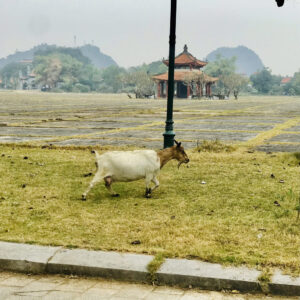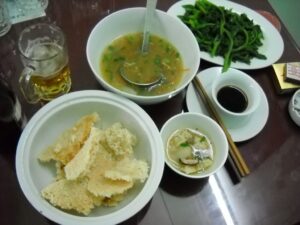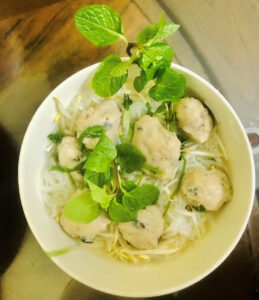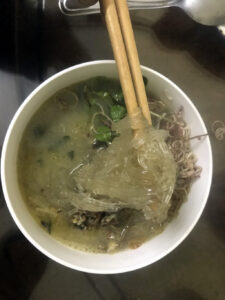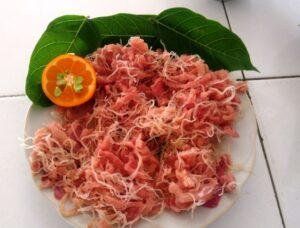The natural beauty and long history combined with generous and friendly people attracts many local and foreign tourists to this iconic province. Like most Vietnamese districts, it also has rich gastronomic specialties.
Nature has given Ninh Binh the towering green limestone mountains that rise above the clouds, the countless clear water streams and lakes and an astoundingly diverse wildlife and a stunning fauna. History has favoured Ninh Binh as well, with the myriad temples, pagodas and grottoes that remain today to testify to Vietnam’s inception. But it doesn’t end there.
The gorgeous topology, fertile soil and abundant fresh water has resulted in the purest and most quintessential Vietnamese produce you are likely to find anywhere. At Discover Ninh Binh, we proudly showcase some of the more unusual specialty foods that define the province’s long and unique “cultural identity.”
Com Chay Ninh Binh
Scorched rice in its many variations is a well-known dish worldwide. As Nurungji, it is a much loved nutritious dish in Korea. In China, people enjoy “guōbā” as a favorite snack and use it as a condiment in many dishes while in Indonesia, they call it Intip and sundry it after cooking to give it an extra crunchy texture. In Japan, they call it Okoge and in Iran and Afghanistan, they like it with vegetables and call it Tahdig. Hopefully, this gives you the picture: scorched rice is a favorite across many countries and cultures.
In Vietnam, people call scorched rice Com Chay and sell it in many markets, restaurants, kiosks, street stalls, and even supermarkets. Manufactured or home cooked, its preparation will vary from region to region but basically it is recooking (“scorching”) dried rice cakes in oil until they change color to golden brown.
But like many “simple” foods, the process takes some practice, a little flare and good ingredients. Officials have officially acknowledged Cơm Cháy Ninh Bình as one of Vietnam’s 10 most famous specialties.
As any local will tell you, half the secret lies in the rice itself. Farmers grow the rice in the Red River flood plains, where rich soils, abundant clear water, and large fields help produce rice that is particularly rich and flavorsome.
Preparation
The base and most of the ingredient is, of course, rice. This is usually a mix of 50% glutinous (“sticky rice”) and 50% “normal” rice. Traditionally, the rice is first boiled in a large, thick walled cast-iron pot. The important thing here is that the chef must continually balance and stir the rice and water combination so that the rice becomes sticky at the bottom and releases bits of the slowly scorched rice but at the same time never burns.
Once the mixture reaches the desired consistency, workers take it outside and sun-dry it in thin squares or circular slabs. The slow process helps retain the rice’s sweetness and removes excess water. They then deep-fry the dried slabs until golden brown, often mixing the oil with other ingredients. Scallions, chili and fish sauce are common but largely depends on the chef’s tastes and desired outcome. People often sprinkle Pork Floss (chà bông) or Dried Shrimp (tôm khô) on top to give it that extra zing.
Aside from a snack, guests can enjoy it with mountain goat or a dipping cracker with sweet pork or meat sauces. A popular alternative is shiitake mushrooms and chopped carrots for a sweet, vegetarian alternative. The richness of the sauces combine with the crispy, sweet, and light flavor of Com Chay to create a deceptively simple dish that explodes onto the palette. Whether you try it as a snack, as a meal, manufactured or home cooked, no visit to Ninh Binh is complete without at least one sampling of Com Chay Ninh Binh.
Mountain Goat
It is impossible to mention Com Chay in this “sacred land of extraordinary people” without mentioning mountain goat meat. Many people in Vietnam raise goats, but the most notable and renowned are those from the Hoa Lu – Ninh Binh highlands.
Raised by farmers on the steep limestone mountains that “reach for the horizon”, the Ninh Binh goat are true mountain goats, grazing on the unique plants and herbs of these iconic Karsts. People believe that this diet allows the goats here to absorb the “essence of heaven and earth,” resulting in soft, chewy, and exceptionally lean meat.
Like any meat, the preparation of goat varies greatly, such as pan fried, grilled, barbecued, slow cooked and so on. People consider “Dê Tái Chanh” a Ninh Binh specialty food, though its English translation, “Boiled Goat with Lemon Juice,” sounds less appetizing. Mrs Cuc Daisy of Ninh Binh, shared with us the traditional method passed down by her family to rid the goat meat of its strong smell and make it sweet and refreshing.
Preparation
First, the chef thoroughly washes a carefully selected portion of fresh goat and allows it to drain. Then they prepare a marinade using a mixture of ginger, galangal root, lemongrass, and any special herbs or spices they prefer. The chef allows the washed meat to sit in the marinade for about 20 minutes, massaging it gently to help the spices fully absorb.
After a short while, the chef removes the meat from the marinade and lightly steams it until it reaches a “rare” state—cooked but still moist. Once the chef decides it’s ready, they take the meat off the heat and place it in a cool, shaded spot to let it settle. A modern alternatively is chill the meat in a refrigerator for 30 min or so.
Either way, once the meat cools, the chef slices it into thin strips and applies a second marinade. Lemon juice serves as the base ingredient, acting as both a flavoring and a tenderizing agent. Depending on the chef’s personal preference, they may also add condiments like sugar, coriander, salt, fish sauce, sesame seeds, and additional ginger and herbs.
Patience
Left to sit for several minutes, the lemon juice breaks down any remaining toughness of the meat while the added herbs and spices serve to enhance the flavor. There is no need to recook and the meal is can accompanied by fig leaves, carambola, and a Vietnamese traditional soy sauce. The sweet and slightly chewy meat bursts with the gentle spiciness of chilli, galangal and lemon grass complemented by the harshness of fig leaves and carambola.
Some say that dipping the succulent mixture into traditional Vietnamese soy sauce evokes the emotional intensity of a first kiss. Perhaps it’s a lingering influence from the long French occupation – but one thing is certain: Vietnamese people truly love their food! Try it before you disagree!
Cá Rô Tổng Trường- Ninh Binh Climbing Perch
Visitors to Am Tien Cave and Pagoda, often admire the scenery of the clear blue lake and the mosaic of moss on the shallow bottom that swarms with schools of fish swimming around the lotus flowers. Living under the shadow of the reflected high mountains imprinted on the lake surface, these fish live in a fairy tale setting with a very tasty ending.
The schools of fish raised at the bottom of this lake are not only your typical Asian Koi but also a peculiar species of perch endemic to the flooded valleys and rivers of Trang An and its surrounding area. Once considered an “offering to the king,” this Ninh Binh specialty fish is now a succulent delicacy that everyone can enjoy.
Locals call this fish cá rô đồng (copper perch), while scientists know it as Anabas testudineus. Vietnamese colloquially refer to it as the “Tổng Trường climbing Perch”. This last name derives from the amazing ability of the fish to migrate to different waterholes and streams by crossing land – usually in the rainy season and usually at night.
Morphological similar to the field perch, its long evolution in the Ninh Binh limestone enriched waters has turned its scales a gray-green color with the abdomen much lighter than the rest of the body (hence the “Copper Perch” moniker). “Tổng Trường” is an ancient name for Trang An and hence its full Vietnamese name of “Tổng Trường cá rô đồng”. Quite a mouthful, not unlike the fish itself!
Preparation
Like most perch, the cá rô đồng are omnivores, feeding off aquatic molluscs, small fish, insects and waterborne foliage, including moss and grass. Like any fish, the methods to cook it are very diverse, including fried, baked or braised in a variety of sauces. The species have become quite common through out Vietnam due to its sweet tender flesh but the regional specialty in its homeland of Ninh Binh is to turn the local “Tổng Trường cá rô đồng” into a rich sweet- sour soup.
To prepare this signature dish, the chef first lightly boils the fish to separate the meat from the bones. Then, they grind the bones into a paste and boil it with water and salt to create a strong fish stock. While this is happening, the fish meat itself is sautéed with sliced shallot, fish sauce and crushed ginger to reduce any of the “muddiness” that sometimes occurs with any fresh water fish. When both are ready, the chef adds leaf mustard greens, rice noodles, freshly fried fish meat, and selected herbs to the broth.
The delicate aroma of the broth, the softness of the boiled rice noodle together with the spicy taste of the ginger laced oil and the fragrant aroma of the herbs and shallots blend to create a unique masterpiece of the culinary arts. As our resident food editor puts it “when eaten, it endures on the tongue and sparks an image of green-yellow rice field surrounded by high green mountains and the rays of the sun through the clouds illuminating the “little souls” like a mother’s love enveloping her child”.
Kim Son Vermicelli Soup
If the combination of Dê Tái Chanh and Ninh Binh Com Chay gives us the feeling of harmony, then Kim Son pork meatball vermicelli gives us the feeling of returning to a lover after so many days apart. You can find Bun Moc, or Pork and Mushroom Meatball Soup, throughout North Vietnam, but Kim Son Vermicelli Soup stands out because, while it looks simple and basic, its taste offers a whole different experience!
Preparation
In its basic form, chefs prepare Kim Son Vermicelli Soup by cooking vermicelli noodles in a broth made from pork bones simmered for at least a day. They then filter the broth to make it clear before adding the noodles. To finish, they add a little green spring onion for aroma, chopped sawleaf for flavor, and sliced shallot fried in oil for a slightly crunchy texture.
To finish, the chef liberally adds meatballs the size of a small baby’s fist, a few slices of Chả Lụa (pork roll), and a sprinkle of pepper for flavor—creating yet another Ninh Binh specialty food.
The chefs of Kim Son make the meatballs using a “secret” recipe, but like many other Vietnamese meatballs, the core ingredient is Giò Sống (ground pork). The secret lies in the chef’s expertise in estimating the right ratio of additional ingredients like salt, pepper, seasonings, and chopped pork rib cartilage. To test the quality, chefs mold the meatballs and lightly blanch them in the pork bone broth before tossing them onto a cutting board to check their “bounce.” As a result, the meatball in Kim Son pork meatball vermicelli is unique and the dish makes a superb lunch or breakfast.
Steamed Mountain Snails
Humans are one of the most developed organisms on the planet with exceptional intelligence and the capacity to adapt to any environment, allowing them to thrive. Along with the success in populating the earth, they have also developed classes and strata in society to control and raise the bar in order to fulfill and satisfy their needs and desires. However, even with the exceptional changes in today’s modern society, there are still famous recipes that have survived centuries.
It is not surprising that nature has provided these rich fields and limestone mountains at Ninh Binh with animals and plants that provide nutrition to mankind. The rice that makes Com Chay Ninh Binh is one example. The succulent mountain goat meat and the endemic Tong Trường Perch are others. One further example is the humble Ninh Binh mountain snail.
These large and distinctive molluscs are not easy prey as they mostly live in darkened caverns and caves in specific regions such as Nho Quan district, Tam Diep city, and Yen Mo. They only emerge to eat and reproduce during the rainy season in Vietnam, which lasts from April to August each year. During this season, farmers must go early in the morning to catch them as for the remainder of the day they retire behind thick foliage and in rock crevices to rest and evade predators. As a result, the Ninh Binh mountain snail makes an exceptional and rare cuisine experience.
A Magical DIet
Mountain snail diet is diversified but primarily plants, particularly precious Chinese herbs that grow wild in the caves and fissures of the limestone cliffs. Once caught, a chef will often wash the gastropod carefully – just enough to clean it but not lose the “traditional medicine” taste of its rare herb diet. Chefs may prepare the snails in a variety of ways, including grilling, frying them with tamarind, steaming them with lemongrass, and more However, a popular and simple way to prepare them is to steam with coconut water, lime leaf, and citronella for around 20-30 minutes and then serve with garlic fish sauce, chilly, ginger, sugar, and lemon.
The dish begins with the cool sweetness of fresh coconut water, mixed with the tantalizing taste of lime leaf and the mild spiciness of citronella and chili. Diners are encouraged to chew the snails slowly, letting the gentle aroma of rare Chinese herbs linger on the palate. As our resident foodie, Grizz, puts it: “It brings to mind trying to catch moonbeams on a cold and lonely night, then realizing it’s an illusion—and choosing instead to simply enjoy the dream-like beauty of the moment.”
Eel with Arrowroot Vermicelli
Along with its lengthy history, wet rice cultivation has been a particularly crucial prerequisite of Vietnam’s growth and strength. Folk songs, choruses about green rice fields or golden stork wings flying over a harvest field color a mother’s lullaby to a Vietnamese child. Passed down by word of mouth from generation to generation, Vietnamese have long recognized the great value that agricultural endeavor has wrought from the rich lands around Ninh Binh.
The Vietnamese eel is an elongated finless fish with a natural slippery secretion that makes catching them difficult. Sometimes mistaken for a snake, it survives by burrowing in the mud in wet rice fields or in the banks tiny rivers and streams. Vietnamese people have long considered these eels a traditional nutritional food, widely recognized for being rich in vitamins, minerals, and flavor. For Ninh Binh, Eel with Arrowroot Vermicelli is one of the special meals that travellers should not neglect when visiting the area.
Preparation
Eels captured in damp rice fields will be first cleaned and filleted to eliminate any odors and to separate the bones and flesh. Chefs combine the eel bones with pork bone broth to create a rich stew, while they sauté the remaining eel meat in oil until golden. After straining the pork and eel broth to produce a clear, flavorful soup, they add arrowroot vermicelli along with Piper lolot leaves and Vietnamese coriander. Finally, they add the fried eel meat, topping the dish with chopped scallions and fried shallots. To finish, they squeeze in a bit of lime for acidity and sprinkle pepper to give the dish some “bite.”
Usually eaten with sliced banana blossom and sprouts, the soup is a rich, aromatic sensation. As Grizz puts it: ” Toothsome and gorgeous. The flavors blend like pink clouds after a hard day’s work, while the rich broth brings back the sweet successes of the past glorious years, like rose buds opening after an evening washing from a peaceful night rain”. Definitely worth a try!
Nem Chua Yên Mạc
Filial piety is a “spiritual heritage” and a standard measure of the spirit of the Vietnamese people. Not only part of people’s belief in ancestor worship, but as part of everyday life. According to tradition, a devoted daughter in Yên Mạc created Nem Chua Yên Mạc out of filial piety for her father, a former official in the Nguyễn court. The fermented sour pork roll is said to embody, in culinary form, the essence of filial piety – a core value in Vietnamese culture.
The major component in Yen Mac fermented pork roll is of course, pork. Chefs carefully select and process pork skin, then boil it. Once cooled, they slice it into long strips and combine it with pork meat, wrapping the mixture in guava and banana leaves. They then ferment the packets in a blend of thính (ground roasted rice), pepper, salt, and garlic. To judge the success of the final product, they evaluate its salt content, the texture of the toasted rice, and the dryness, suppleness, and flexibility of the rolls.
Sundried Freshness
Once the chefs deem the spring rolls acceptable, they place them outdoors to ferment for 1 to 6 days, depending on the temperature. They serve the Yên Mạc fermented sour roll with garlic dipping sauce, chili, and sugar—all wrapped in fig leaves. The mild sour flavor of fermented pork, the soft chewy pork skin, the hot taste of chili combined with the taste of fish sauce is a rare treat as the number of people still willing and able to go through the laborious process and learn the secret skills grows fewer every year. If you get the chance, don’t ever pass over the famous Nem Chua Yen Mac !
As our resident foody Grizz says “When combined with a cup or two of Kim Son rice wine – Nem Chua Yen Mac generates an exquisite, spicy flavor on the tip of the tongue. On the chilly rainy days of winter it brings the touch of nature ‘s “breath” and clears all the cares and anxieties in each person’s thoughts” Or maybe that is just the potent Kim Son rice wine!
Ant Egg Sticky Rice
The meal known as Xôi Trứng Kiến or Ant egg sticky rice is another Ninh Binh Specialty Food, albeit a little more exotic and perhaps only for the more adventurous. The dish is relatively expensive and very seasonal due to the difficulty of collecting the right sort of ant eggs. Farmers must wait for the day the black and brown ants breed and then harvest the ant nests on sunny, dry days otherwise the eggs cling together and ruin the quality.
Any remaining brown ants are filtered out before the eggs are washed and then blanched with hot water and left to dry. The prepared eggs are then sautéed in chicken fat and chopped shallots to provide a rich garnish. “Sticky” glutinous rice cultivated in the Ninh Binh highlands is steamed with fresh mung beans and gac fruit to provide color . Finally it is served on a plate with the sticky rice on the bottom and the ant egg and fried shallots mixture on top.
As our favorite foodie describes it; “When you chew, you will love hearing the sound of the eggs breaking, causing hundreds of small “beeps” in your mouth like listening to symphony music when the high notes blend with the flute and sound like clouds in the afternoon over the sea, softly dragging each wave to touch the “vibration” of the heart”. I think I need some more of that Kim Son rice wine …
Gỏi Nhệch Kim Son
Sashimi is the Internationally famous Japanese dish made from raw seafood. Similarly, a basic fish salad (Goi Ca) made from uncooked fish is popular in many places in Vietnam, usually accompanied with herbs, chili, Nuoc Mam (fish sauce) and fig wrapping leaves. As a variation of the theme, Gỏi Nhệch is another popular Vietnamese raw seafood salad, this time prepared from the small fry of rice-field eels.
The southern Ninh Binh district of Kim Son’s has its own version of this distinctive salty raw fish salad and is one of the many meals on the list of Ninh Binh Specialty Foods. The Nhech (baby eel) that reside in the many Ninh Binh estuaries and coastal lagoons are the raw material for this appealing and rustic cuisine but they are quite powerful and aggressive and their bodies are also slippery, making them difficult to capture.
Preparation
Making this salad is simple, but it must be done quickly to avoid the fishy taste and maintain the freshness of the meat. The Nhech is first processed after being caught by washing it thoroughly in a water and lime juice mixture before removing the belly and organs and separating the bones from the flesh. The fish meat is then thinly sliced, squeezed with fresh lemon juice, and seasoned with traditional seasonings. The fish skin and bones will be boiled and mixed with herbs and spices and used as a dipping sauce.
To enhance the taste, the dish is most often served with green plants such as fig leaf, lemongrass, perilla, mint, and ginger, as well as chopped Galangal, chili, and raw shallot. Using the fig leaf as a “skin”, you then fill it with the eel meat and your desired condiments then roll it up much like a spring roll or banh cuon. The rich flavor of the prepared sauce combined with the fresh crunchiness of the fried eel, the mild sourness of lime, the roughness of fig leaves, and the fiery flavor of chili peppers is a true taste sensation.
Bun Cha Ninh Binh
Bún Chả, like Phở, is a famous meal that most travelers in Vietnam should be familiar. Bun Cha Ninh Binh provides tourists with a unique experience that can only be found in this region. The spring rolls (nem chua) are made with minced fatty pork using a secret recipe that includes minced shallots, pepper, and garlic which are then barbequed over charcoal for 30-45 minutes. Sweet and sour fish sauce and papaya are served with fresh rice vermicelli and vegetables such as lettuce, Vietnamese balm, mints, bean sprouts, and spring onions to add flavor. The fatty scent of meatballs, fresh rice vermicelli gently dipping in sweet and sour papaya fish sauce gives diners a hearty sweet-sour flavor that is is difficult to describe but generally thought of as one of the truly great North Vietnamese dishes.

